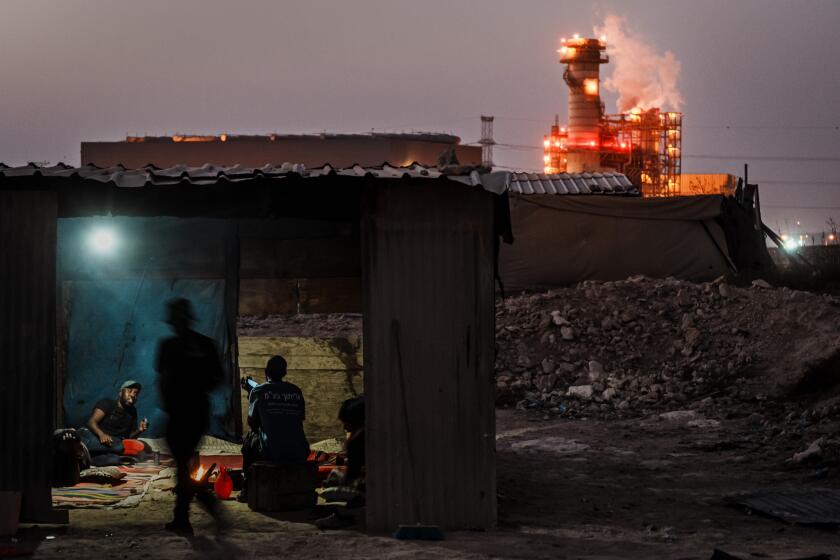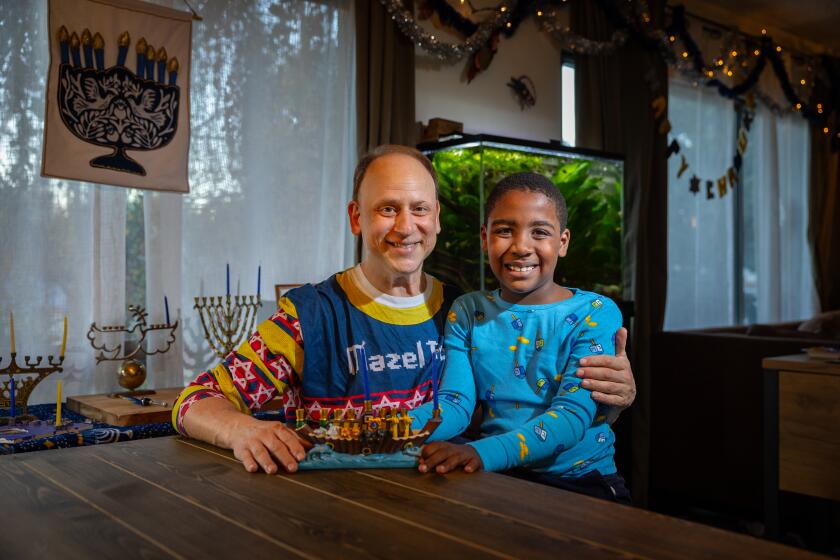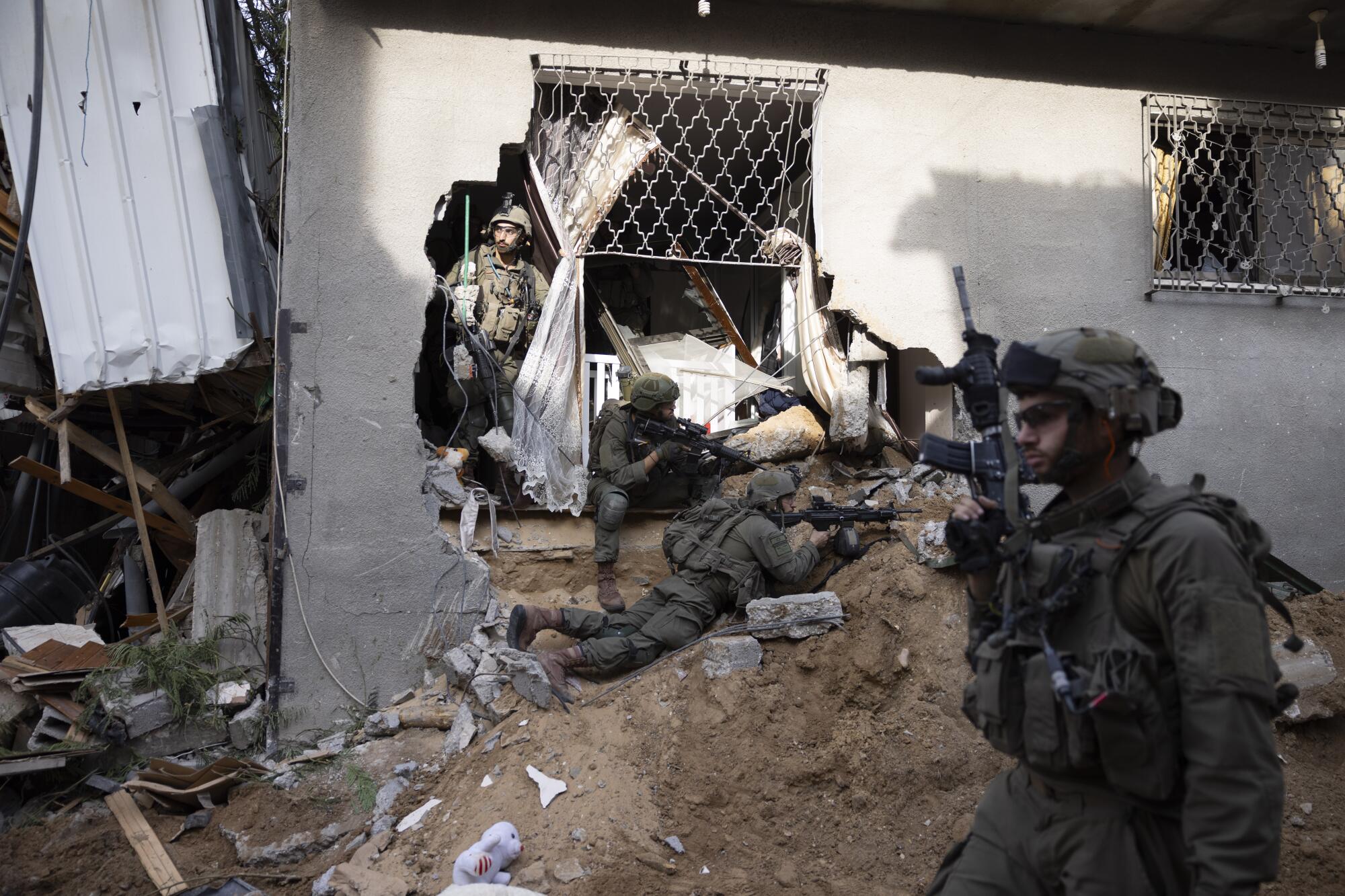
- Share via
TEL AVIV — Israel’s defense minister on Monday pushed back against international calls to wrap up the country’s military offensive in the Gaza Strip, saying the current phase of the operation against the militant group Hamas will “take time.”
Yoav Gallant, a member of Israel’s three-person war Cabinet, remained unswayed by a growing chorus of criticism over the widespread damage and heavy civilian death toll caused by the two-month military campaign. The United Nations secretary-general and leading Arab states have called for an immediate cease-fire. The United States has urged Israel to reduce civilian casualties, though it has provided unwavering diplomatic and military support.
Israel launched the campaign after Hamas militants stormed across its southern border on Oct. 7, killing at least 1,200 people and kidnapping about 240 others.

Two months of airstrikes, coupled with a fierce ground invasion, have resulted in the deaths of more than 17,000 Palestinians, according to health officials in the Hamas-run territory. They do not give a breakdown between civilians and combatants but say that roughly two-thirds of the dead have been women and minors. Nearly 85% of the territory’s 2.3 million people have been driven from their homes.
In a briefing with the Associated Press, Gallant refused to commit to any firm deadlines, but he signaled that the current phase, characterized by heavy ground fighting backed by air power, could stretch on for weeks and that further military activity could continue for months.
“We are going to defend ourselves. I am fighting for Israel’s future,” he said.
After seven weeks held hostage in the tunnels of Gaza, they are finally free to laugh and chat and play.
Gallant said the next phase would be lower-intensity fighting against “pockets of resistance” and would require Israeli troops to maintain their freedom of operation. “That’s a sign the next phase has begun,” he said.
He spoke as Israeli forces battled militants in and around the southern city of Khan Yunis, where the military opened a new line of attack last week. Battles were also still underway in parts of Gaza City and the urban Jabaliya refugee camp in northern Gaza, where large areas have been reduced to rubble and many thousands of civilians are still trapped by the fighting.
Israel has pledged to keep fighting until it removes Hamas from power, dismantles its military capabilities and gets back all of the hostages. It says Hamas still has 117 hostages and the remains of 20 people who died in captivity or during the initial attack. More than 100 captives were freed last month during a weeklong truce.
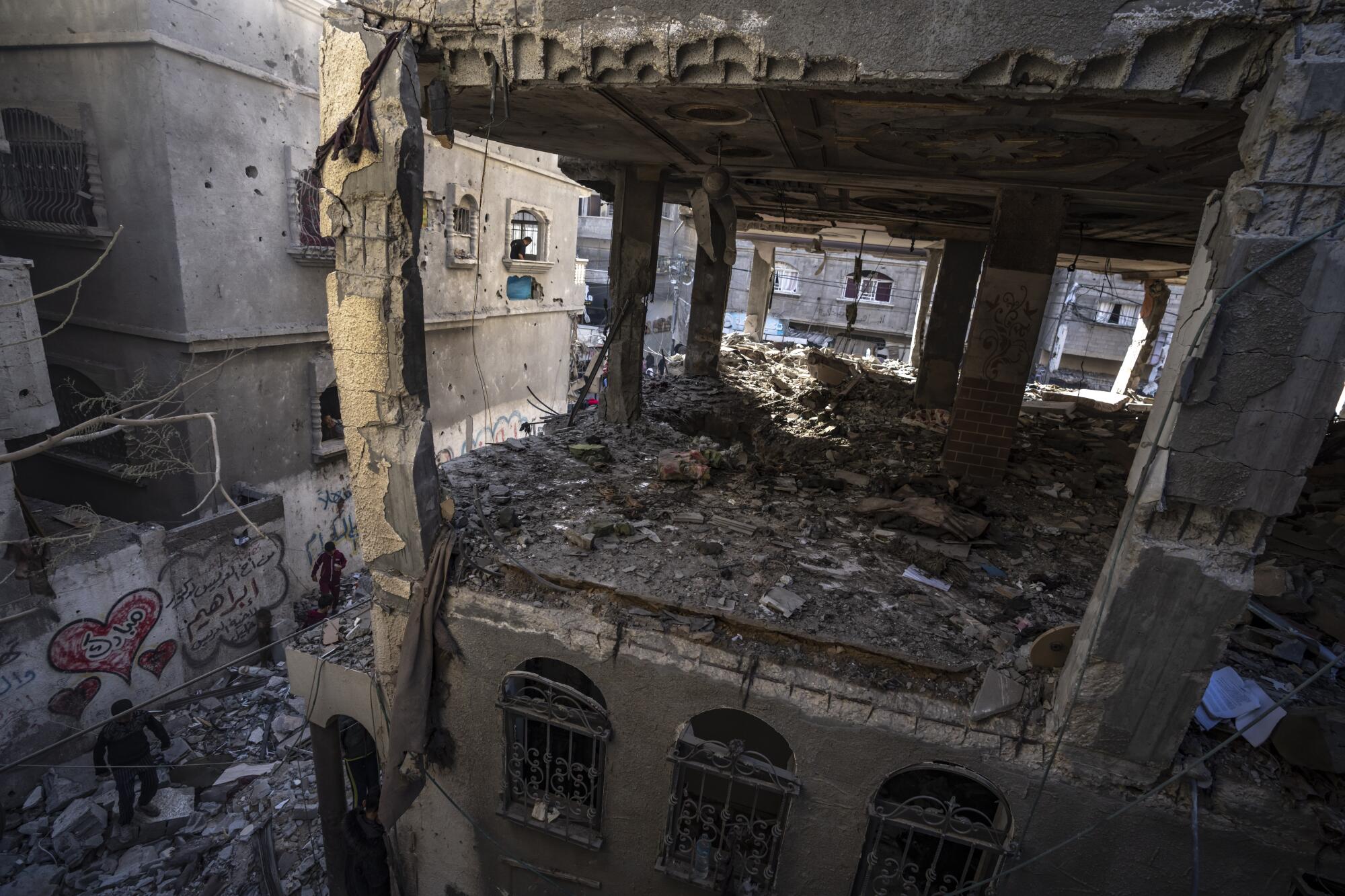
On the desk in his spacious office, Gallant keeps a framed picture of all the children taken hostage. All but two are marked with small hearts, signaling their release from captivity.
In central Gaza, an Israeli airstrike overnight flattened a residential building where about 80 people were staying in the Maghazi refugee camp, residents said.
Ahmed Qarah, a neighbor who was digging through the rubble for survivors, said he knew of only six people who made it out. “The rest are under the building,” he said. At a nearby hospital, family members sobbed over the bodies of several of those killed in the strike.
Bedouins of the Negev desert face rockets from Gaza and discrimination and arrest by Israel. They seek safety as the war energizes the far right.
In Khan Yunis, Radwa abu Frayeh saw heavy Israeli strikes overnight around the European Hospital, where the U.N. humanitarian office says tens of thousands of people have sought shelter. She said one strike hit a home close to hers late Sunday.
“The building shook,” she said. “We thought it was the end and we would die.”
Gallant blamed Hamas for the heavy civilian death toll, saying that the militant group maintains a network of tunnels underneath schools, streets and hospitals.
He claimed that Israel has inflicted heavy damage on Hamas, killing half of the group’s battalion commanders and destroying many tunnels, command centers and weapons facilities.
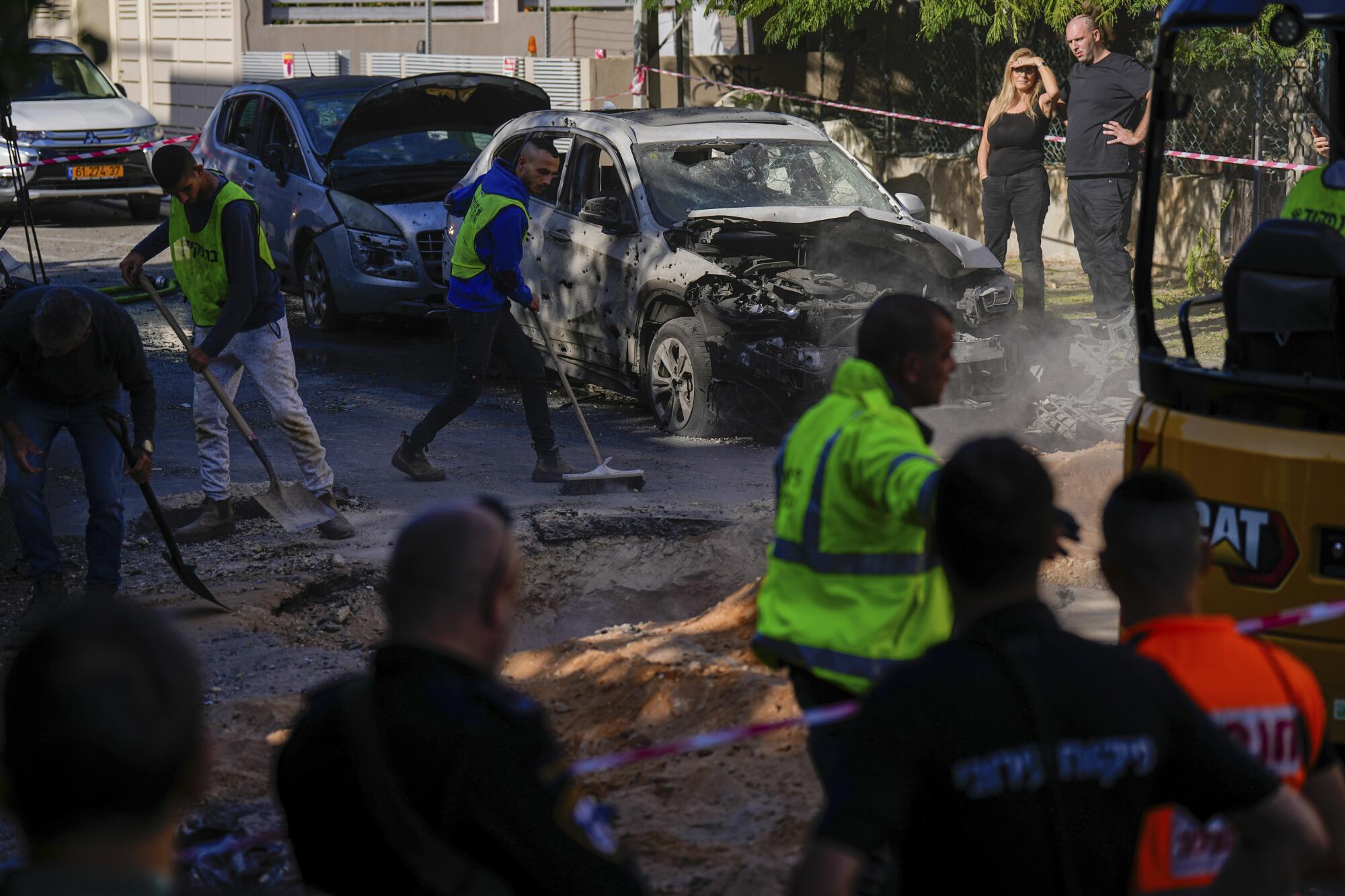
Israeli officials have said about 7,000 militants — roughly one-quarter of Hamas’ fighting force — have been killed in the war and that 500 militants have been detained in Gaza in the last month. The claims could not be independently verified. Israel says 104 of its soldiers have been killed in the Gaza ground offensive.
The result, Gallant said, is that in the northern Gaza Strip, Hamas has been reduced to “islands of resistance” acting on the whims of local commanders.
In southern Gaza, he said, the situation is different. “They are still organized militarily,” he said.
Gallant also said Israel has recovered “hundreds of terabytes” of information about Hamas from computers its troops have seized.
Across the Los Angeles area, home to the second-largest Jewish community in the United States, Jews are unsure how they want to celebrate Hanukkah as the bloodshed continues in the Middle East.
Despite the reported battlefield setbacks, Hamas on Monday fired a barrage of rockets that set off sirens in Tel Aviv, where Gallant’s office and Israeli military headquarters are located.
One person was lightly wounded, according to the Magen David Adom rescue service. Israel’s Channel 12 television broadcast video of a cratered road and damage to cars and buildings in a suburb.
The U.N. humanitarian office, known as OCHA, described a harrowing journey through the battle zone in northern Gaza by a U.N. and Red Crescent convoy over the weekend. It was the first delivery of medical supplies to the north in more than a week. OCHA said an ambulance and a U.N. truck were hit by gunfire on the way to Ahli Arab Hospital to drop off the supplies.
The convoy then evacuated 19 patients but was delayed for inspections by Israeli forces on the way south. OCHA said one patient died, and a paramedic was detained for hours, interrogated and reportedly beaten.
The fighting in Jabaliya has trapped hundreds of staffers, patients and displaced people inside hospitals, most of which are unable to function.
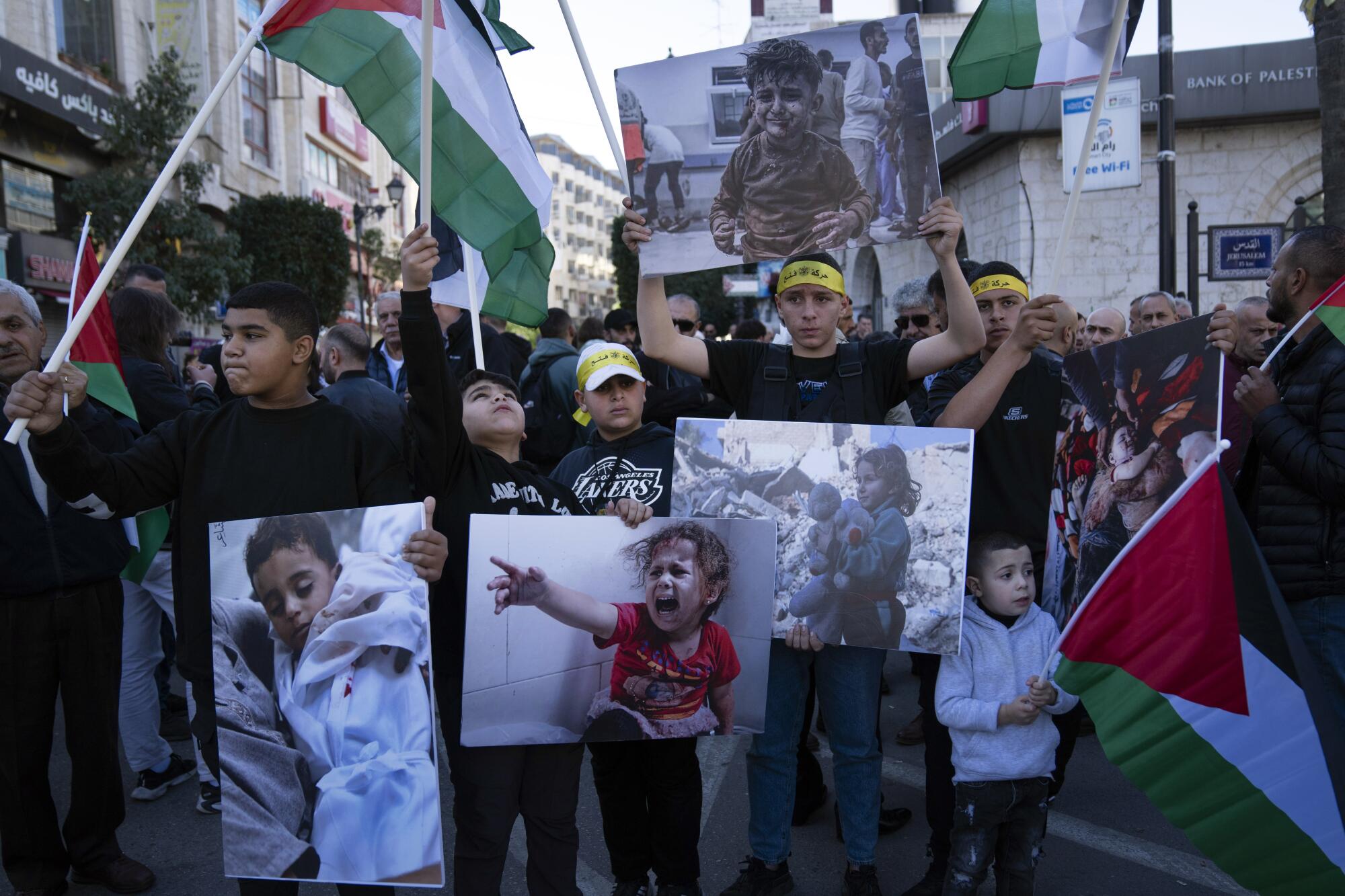
Two staff members were killed over the weekend by clashes outside Al Awda Hospital, OCHA said. Shelling and live ammunition hit the Yemen al Saeed Hospital, killing an unknown number of displaced people sheltering inside, it said. It did not say which side was behind the fire.
With Israel allowing little aid into Gaza and the U.N. largely unable to distribute it amid the fighting, Palestinians face severe shortages of food, water and other basic goods.
Israel said it will start conducting inspections of aid trucks Tuesday at its Kerem Shalom crossing, a step meant to increase the amount of relief entering Gaza. Currently, Israel’s Nitzana crossing is the only inspection point in operation. All trucks then enter from Egypt through the Rafah crossing. Aid workers, however, say they are largely unable to distribute aid beyond the Rafah area because of the fighting elsewhere.
Israel has urged people to flee to what it says are safe areas in the south. The fighting in and around Khan Yunis has pushed tens of thousands toward the town of Rafah and other areas along the border with Egypt.
Breaking News
Get breaking news, investigations, analysis and more signature journalism from the Los Angeles Times in your inbox.
You may occasionally receive promotional content from the Los Angeles Times.
Still, airstrikes have continued even in areas to which Palestinians are told to flee.
A strike in Rafah early Monday heavily damaged a residential building, killing at least nine people, all but one of them women, according to Associated Press reporters who saw the bodies at the hospital.
The aid group Doctors Without Borders said people in the south are also falling ill as they pack into crowded shelters or sleep in tents in open areas.
Nicholas Papachrysostomou, the group’s emergency coordinator in Gaza, said “every other patient” at a clinic in Rafah has a respiratory infection after prolonged exposure to cold and rain. In shelters where hundreds share a single toilet, diarrhea is widespread, particularly among children, he said.
Shurafa reported from Deir al Balah, Gaza Strip, and Jeffery from Cairo. Associated Press reporters Paul Haven and Tia Goldenberg in Tel Aviv, Najib Jobain in Rafah, Gaza Strip, and Samy Magdy in Cairo contributed to this report.
More to Read
Sign up for Essential California
The most important California stories and recommendations in your inbox every morning.
You may occasionally receive promotional content from the Los Angeles Times.

